Can you guess which traditional Japanese craft decorates the World Heritage Sites of Kyoto’s Kinkaku-ji Temple, Tochigi’s Nikko Toshogu Shrine, or Hiraizumi’s Konjiki-do Hall? That's right - Kanazawa gold leaf decorations! The Kanazawa variety actually makes up 98% of the domestic gold leaf market. Although the gold leaf can be as thin as 0.0001 mm, it’s still being produced by hand by skilled artisans who bring this traditional Japanese craft to life one sheet at a time.
What Is Kanazawa Gold Leaf?

Originally, gold leaf was made by hammering gold until it was 0.0001-2.0 mm thin. With this method, you could get as much as 1.62 m² of gold leaf out of 2 grams of the precious metal. Throughout history, gold leaf has been mainly used as decoration for the most gorgeous and magnificent shrines and temples in Japan, such as Kyoto’s Kinkaku-ji Temple or Tochigi’s Nikko Toshogu Shrine. It has also long been used to decorate other traditional Japanese crafts like Wajima-nuri lacquerware.
Several factors are required to hammer the gold as thinly as humanly possible. You need a superb artisan, properly prepared "kami-shikomi" paper that will help you shape the gold leaf, and even the right kind of climate.
In Japan, 98% of the domestic gold leaf market is dominated by Kanazawa gold leaf. The history of the craft in the Hokuriku region goes back more than 700 years thanks to the area’s temperature, humidity, and water quality, which were all ideal for the production of gold leaf. Then, of course, there were the local craftspeople, known for their endurance and skill, who helped make Kanazawa the gold leaf capital of Japan, a legacy that it enjoys to this day.
Related articles:
▶ The Complete Guide to Traditional Japanese Crafts
▶ Traditional Japanese Crafts: The Complete Guide to Japanese Lacquerware
How the Delicate Kanazawa Gold Leaf Is Made

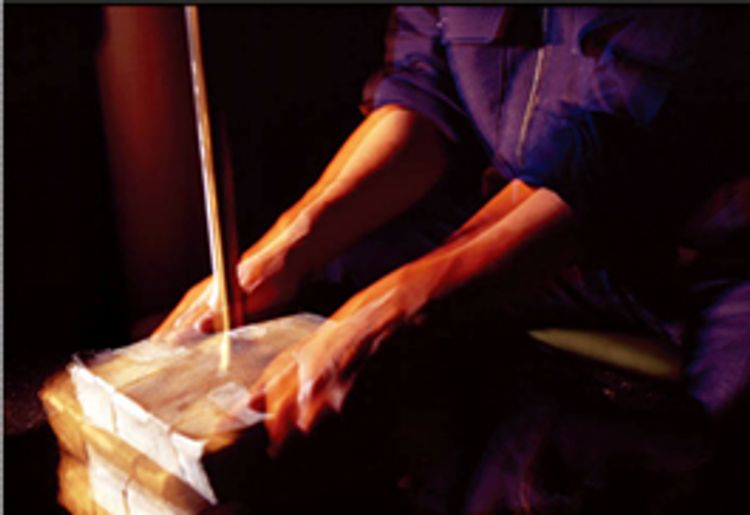
The production process of Kanazawa gold leaf can be broadly divided into six steps:
• Kane-awase
Because gold that is 99.99% pure is too soft to hammer into a leaf shape, and to help control the final color of the product, the gold is alloyed with small amounts of silver and copper. All three metals are heated to around 1,300°C / 2372°F and melted together in a crucible, after which they are poured into molds.
• Nobe-gane
The mixed ingot is then stretched inside a rolling machine. This process is repeated about 20 times until the metal becomes 0.02-0.03 mm thin. Then, the strip is cut into 6 cm squares called "koppe."
• Zumi-uchi
During this process, the koppe will be hammered even thinner between sheets of paper (first picture above). Once the koppe are flattened into 12 cm squares, they are called “aragane.” The aragane are then cut into quarters and hammered again to create 20 cm squares called “koju.” The koju are similarly then cut into quarters and hammered into “oju.” After, the oju are finished between sheets of specially-prepared paper, becoming “uwazumi.” At this point, they’re about 0.003 mm thin.
• Hiki-ire
During this process, the uwazumi is cut into 12 squares called “koma,” which are individually placed between sheets of paper and hammered until they become 0.001-0.002 mm thin.
• Uchi-mae
The resulting "zumi" is placed between sheets of pounding paper and held together with a baren, after which it’s hit repeatedly with a mechanical hammer (second picture above). Once that’s done, the paper is replaced with a kami-shikomi* paper and the gold leaf is flattened to be 0.0001 mm thin.
*Kami-shikomi: An indispensable part of the gold leaf-making process, kami-shikomi is Japanese paper between which artisans insert sheets of gold leaf. It’s made by soaking regular Japanese washi paper in a concoction of eggs, persimmon tannin, or ashes, which makes the paper more durable. The quality of the kami-shikomi will determine the quality of the gold leaf. Experienced artisans know that you can’t make good gold leaf with bad Japanese paper.

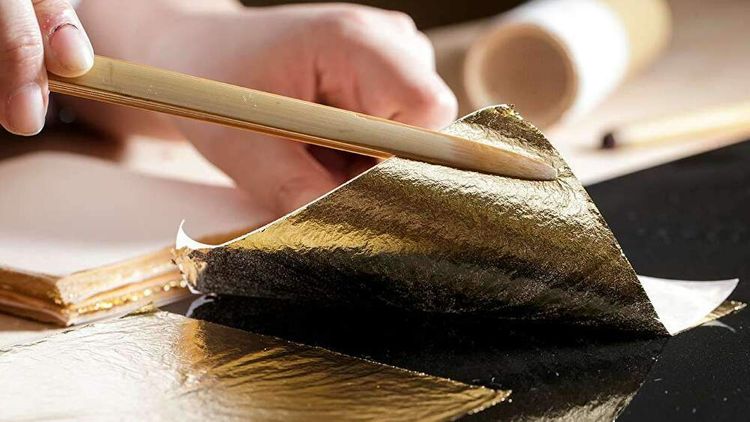
• Nukishigoto
This step involves moving the hammered gold leaf between sheets of Japanese paper in a bundle called the “hiromonocho” while also inspecting the leaf for quality. To do this, the artisan uses bamboo chopsticks, which are less likely to cause an electrostatic discharge, as well as "tengutsume" (rolled-up pounding paper). Remember, the gold leaf is just 0.0001 mm thin, so it can be easily damaged by a small gust of wind or an electrostatic discharge. This step requires a very delicate touch.
• Haku-utsushi
The last step in the process, which involves taking the hiromonocho-placed gold leaf and cutting it to size (first picture above) using a bamboo frame. There are four standard gold leaf sizes in Japan: 10.9 cm, 12.7 cm, 15.8 cm, and 21.2 cm squares. The artisan starts by holding the frame with their left hand, picking a sheet of gold leaf with bamboo chopsticks, placing it on the cutting device, and trimming it down to uniform size. The gold leaf is then placed on a piece of Japanese paper (second picture above), and is then ready for use.
All of this is to make just one sheet of gold leaf. Nowadays, some parts of the process have started to become automated, but many artisans continue to produce gold leaf using traditional ways as an ultimate expression of their skills.
The Allure of Kanazawa Gold Leaf
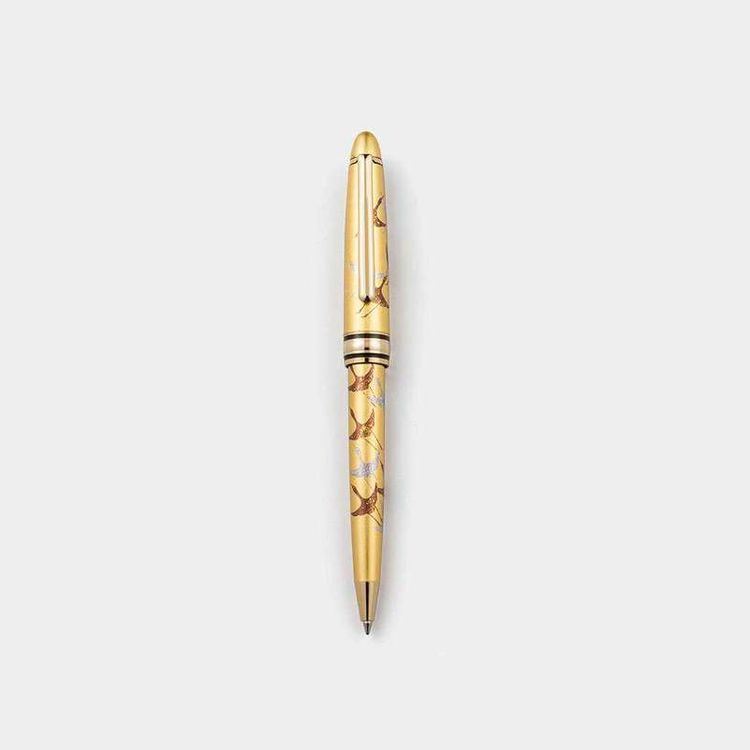
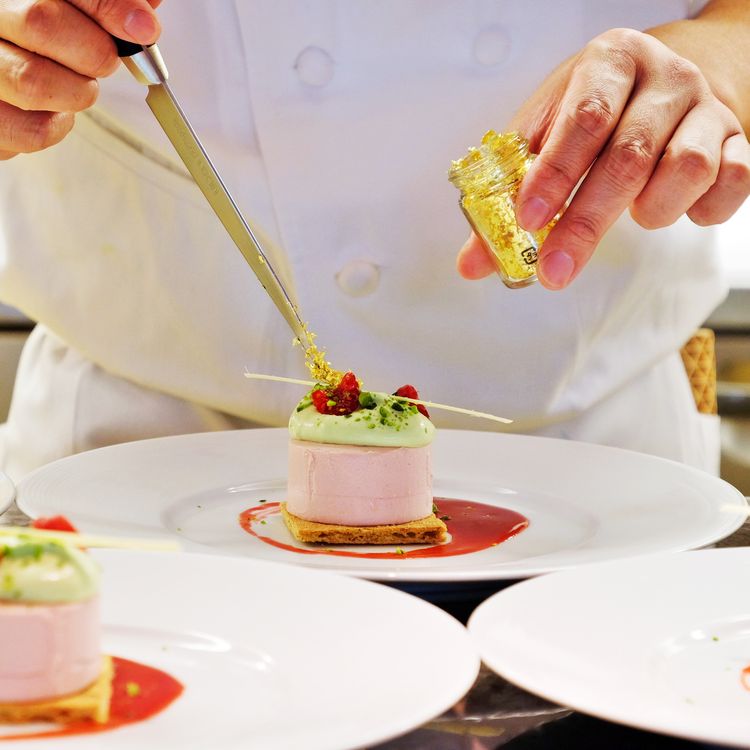
Kanazawa gold leaf (Kanazawa-haku) technically also includes silver leaf, tin foil, and brass foil, giving it a variety of different colors to work with. But that’s not all. Because every metal can be altered by being alloyed with another element, put through some special process, or attached to a surface in many different ways, the artistic potential of Kanazawa gold leaf is near limitless.
Today, gold leaf isn’t found just at shrines, temples, or on traditional handicrafts. It’s also used in cosmetics, candy, edible toppings, architectural decorations, and much, much more.
Featured Products
Oborotsuki Bowl 240 (Lacquer) | Kanazawa Gold Leaf
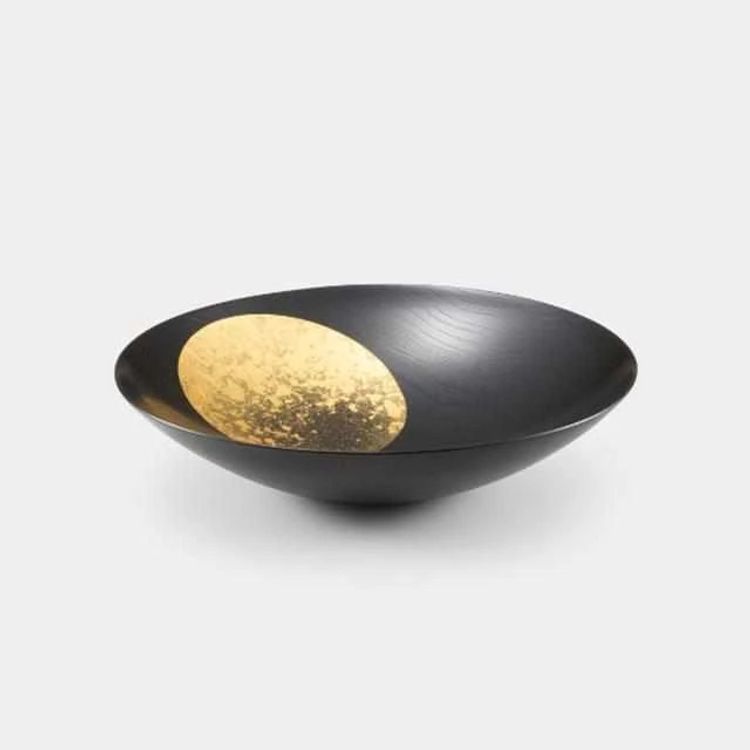
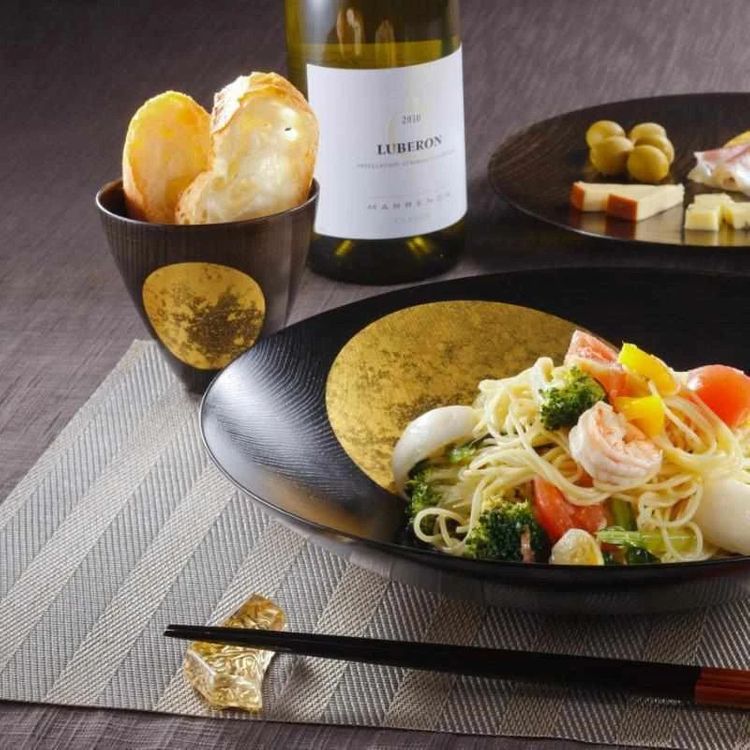
You can admire an image of the pale moon painted with real gold leaf reflecting in the grain of this natural wood bowl. This is an exquisite dish that can be used at any meal, not just a Japanese-style one. Whether you’re looking for a perfect gift or a perfect dish for a special guest or occasion, this is the bowl for you.
Coffee Cup & Saucer Set | Kanazawa Gold Leaf
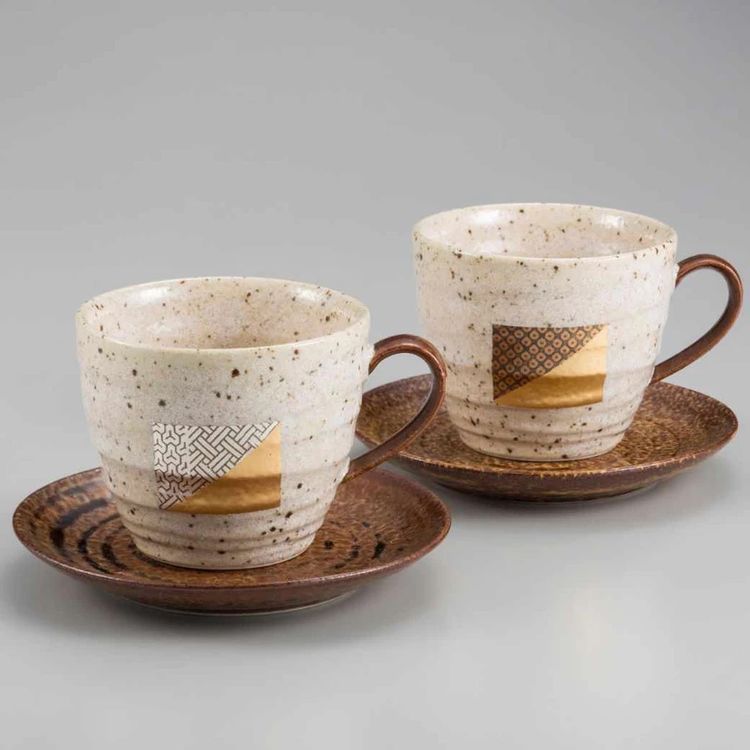
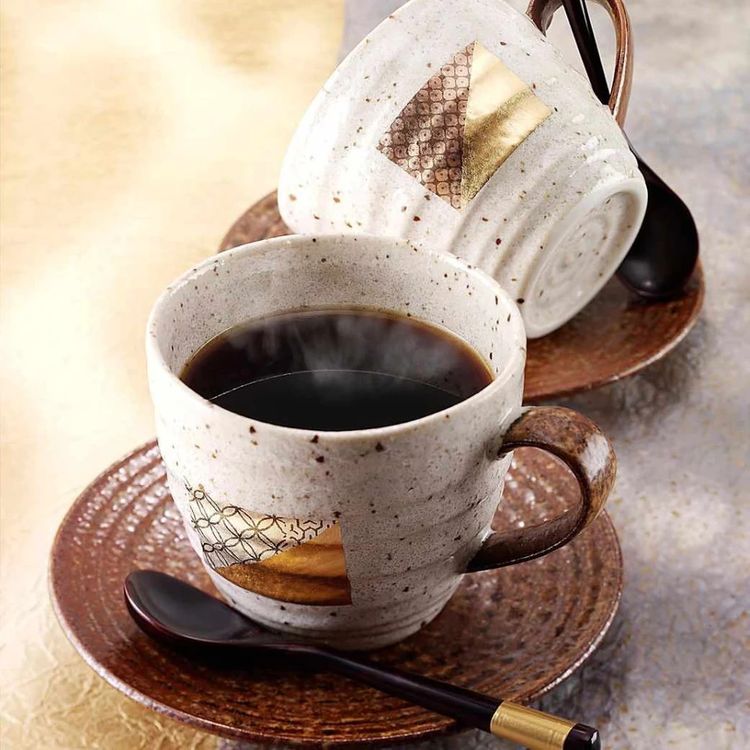
A collaboration between Kanazawa gold leaf and Shigaraki ware (another designated traditional Japanese craft). These warm, earthy Shigaraki coffee mugs feature a “Yuzen haku” design using gold and silver leaf. The mug in the front of the first picture is showing a silver-leaf asamon emblem, which is considered a good luck symbol. The mug in the back of the first picture shows a silver-leaf dappled design. The set would make an excellent gift.
Folding Fan Foil Beauty Kaigetsu (Unisex) | Kanazawa Gold Leaf


Featuring a gold-leaf design of a moon reflecting on the surface of a sea at night, this fan is an exquisite product for people who want to be sure that the utmost care and skill went into every step of the production of this traditional Japanese implement. It comes in a paulownia wood box that makes it easier to protect the fan, as paulownia has strong antibacterial properties and absorbs moisture, which is why it’s also often used to store kimono. If you know someone who’s a "fan" of fans, this would be an excellent gift for them.
Folding Fan Chirashi Beauty Starry Sky Hoshizora (Unisex) | Kanazawa Gold Leaf
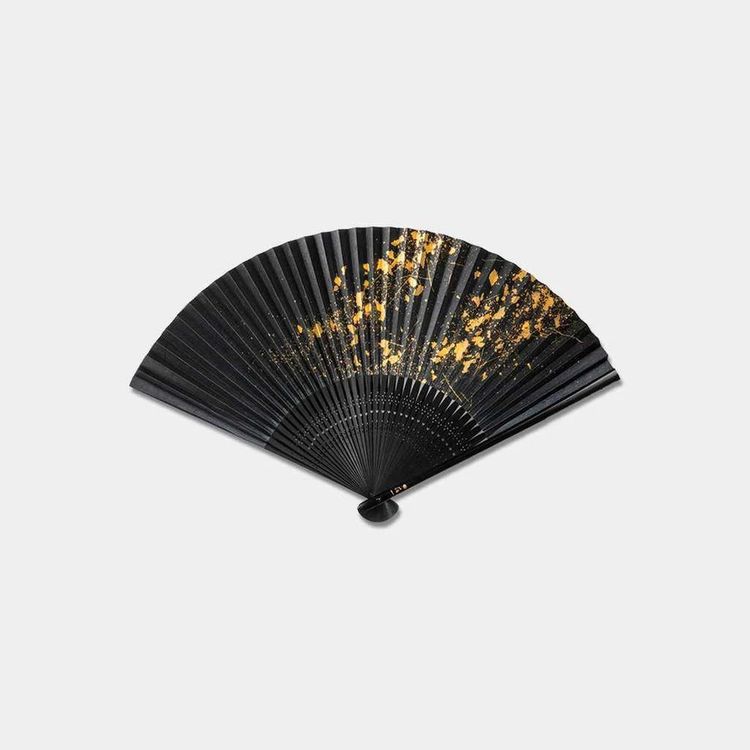

Using a special technique, the gold-leaf pattern on this fan has been made to look like countless shining stars adorning the night sky. The first picture above shows the front of the fan, while the second picture shows the back. With its chic design, the fan is especially recommended for women who prefer simple black garments, or men who enjoy wearing suits.
Folding Fan Ariake Ariake (Unisex) | Kanazawa Gold Leaf
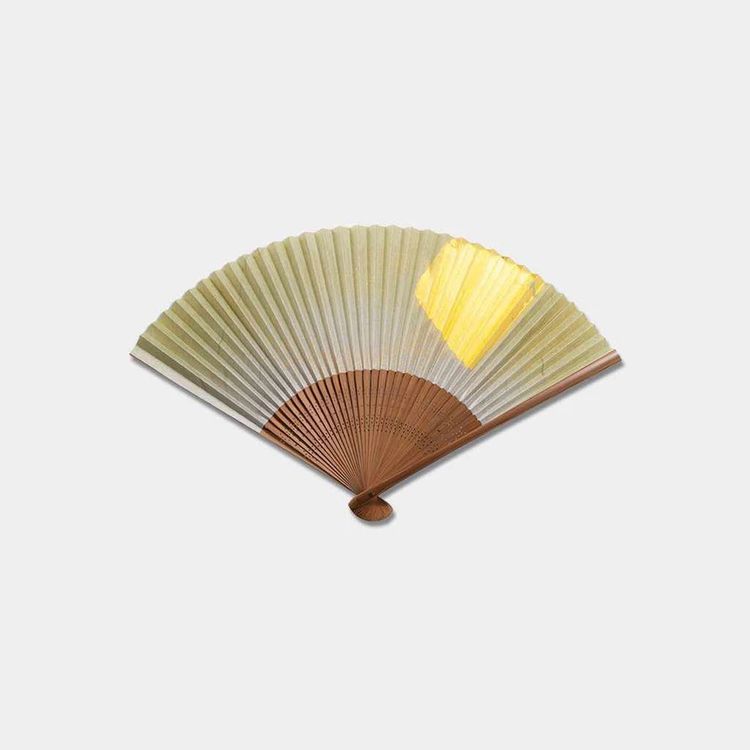
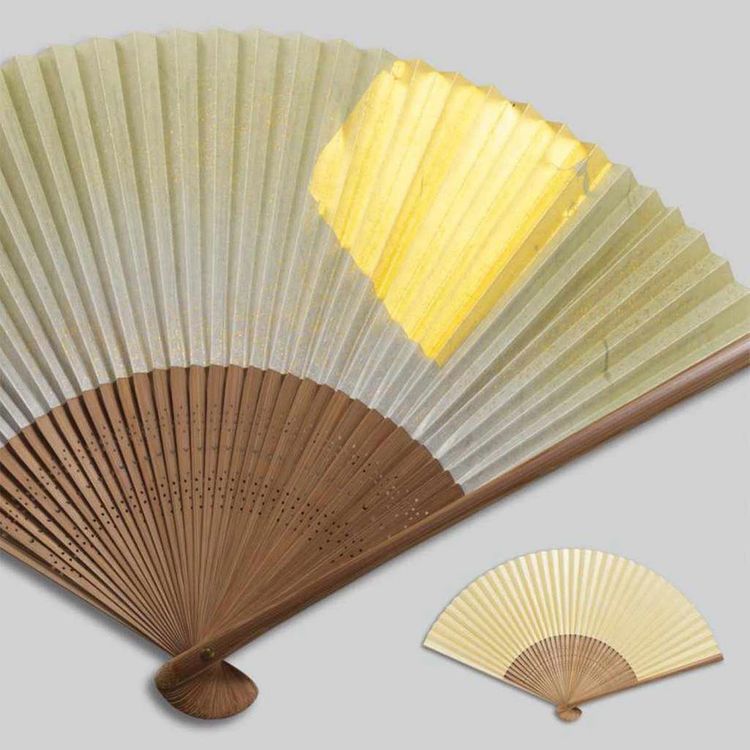
This fan’s gold and silver-leaf design was inspired by the image of the Milky Way lighting up the night sky. The back of the fan (second picture, bottom right corner) features a faint gradation symbolizing daybreak. This is a rather sober design without much flash or vividness, so it pairs well with a kimono look but, other than that, will only work with clothing that is highly elegant and sophisticated.
▶ Click here to browse more beautiful Kanazawa Gold Leaf items!
Related articles:
▶ A Guide to the Traditional Japanese Craft: Kyo-Sensu Fans
▶ A Guide to the Traditional Japanese Craft: Edo-Sensu Fans
▶ 5 Top Japanese Pens That’ll Add Color to Your Life
If you want to give feedback on any of our articles, you have an idea that you'd really like to see come to life, or you just have a question on Japan, hit us up on our Facebook, Twitter, or Instagram!
*These products may not be able to be shipped to certain countries. Please see the retailer's website for more information.
The information in this article is accurate at the time of publication.
